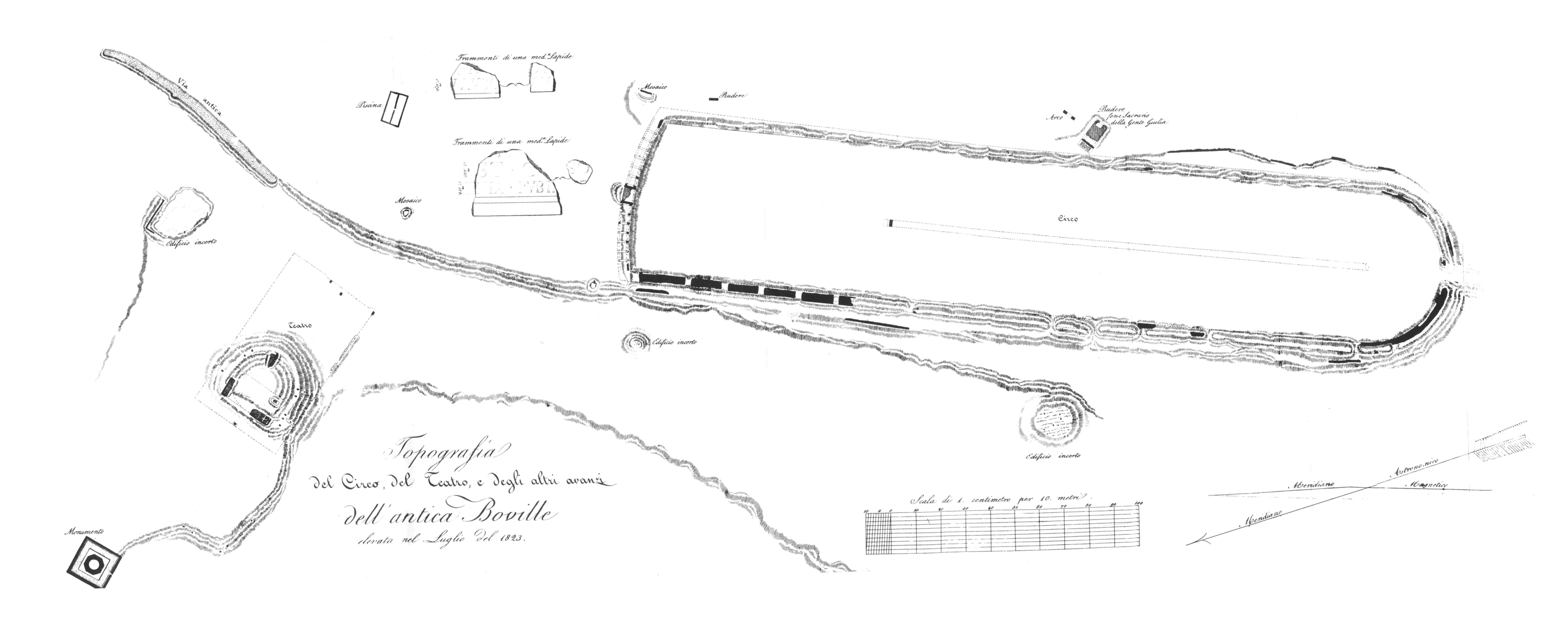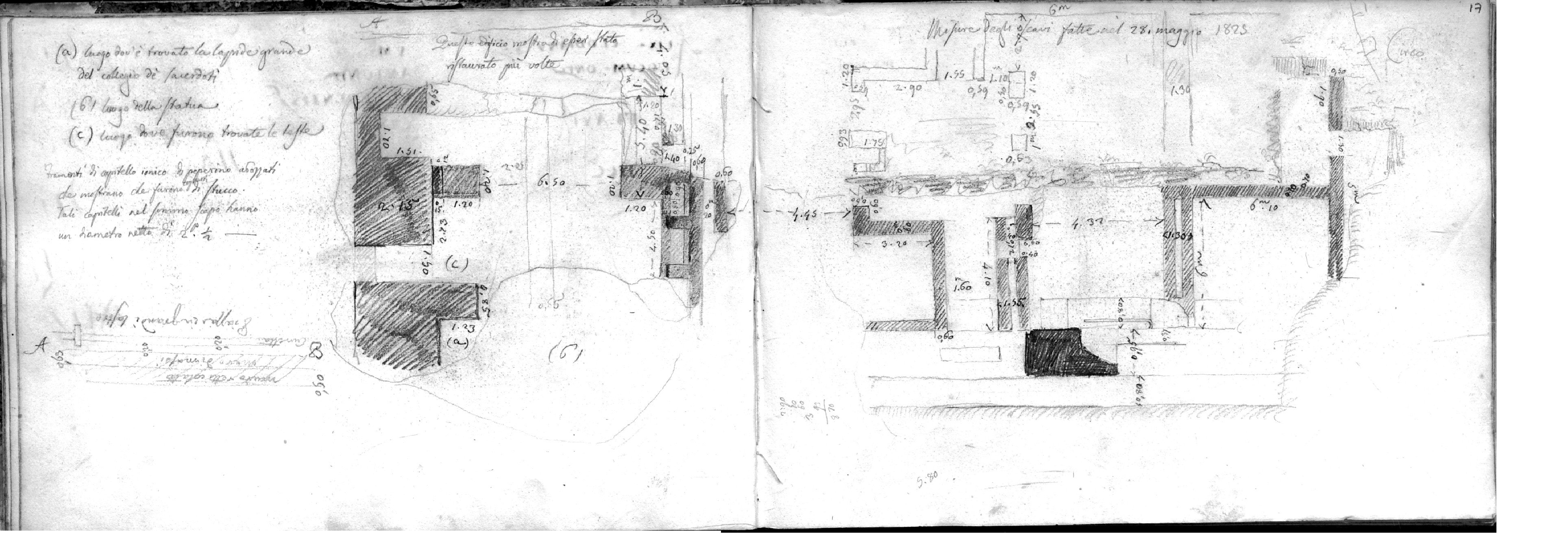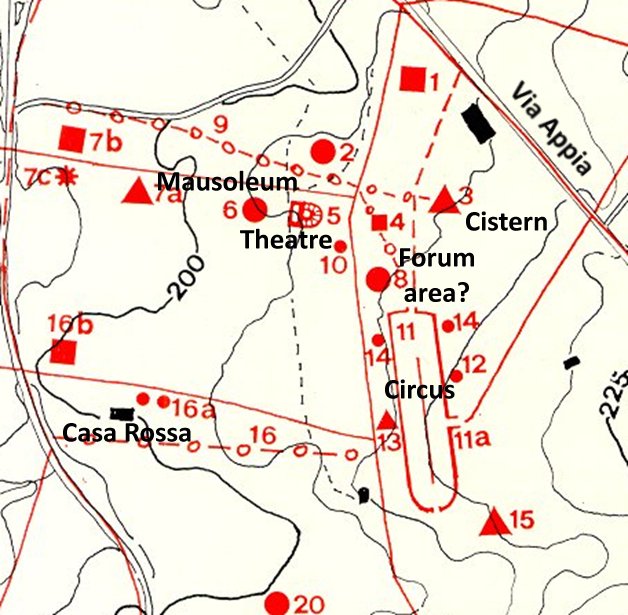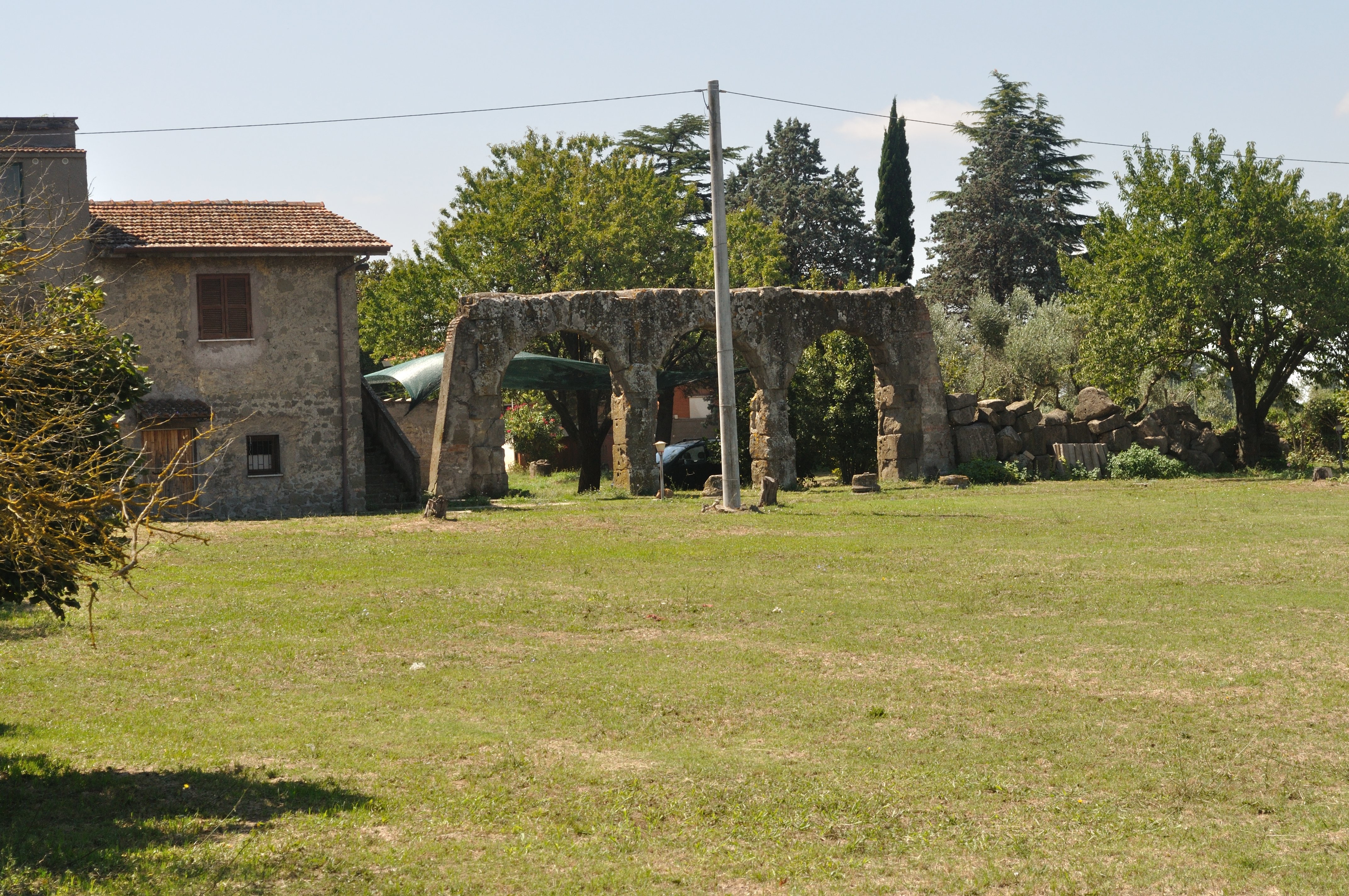| (Contribution jointly with Jan Stubbe Østergaard)[1] |
Caligula: Notes and an Hypothesis on the Context |
Paolo Liverani |
The discovery that the Richmond Caligula was formerly in the Colonna collection and that it had been excavated at Bovillae on the Via Appia in 1825 is a finding of great importance. We owe these discoveries to the acumen of Maria Grazia Picozzi and to her profound knowledge of Roman art collections (Picozzi 1990, 33, 56 note 242).[2] In the wake of these findings, it is necessary to reconsider the topography of Bovillae and the history of the excavations from this location in order to better understand the statue and recover its original context. In the 1820s, interest had grown in locating the site of the Roman city, which had previously been neglected from an archaeological and topographical point of view (although historical treatments existed that were essentially based on the literary and epigraphic sources).
In 1823, topographical surveys and some soundings by Giuseppe Tambroni and Luigi Poletti (1792-1869) made it possible to identify Bovillae's circus, theatre, and a series of other ancient structures (fig. 1).[3]
 |
| Fig. 1: L. Poletti, Archaeological map of Bovillae (Tambroni 1823) |
Tambroni died in 1824 and, therefore, the landowner, Don Vicenzo Colonna, entrusted the continuation of the studies and explorations to Poletti, an architect from Modena who was in his 30s and rising in his career: indeed, a short time later, he became one of the most famous architects in nineteenth-century Rome (Bardeschi 1992). One of his most important projects was the reconstruction of the Basilica of St. Paul outside the Walls after the terrible fire of 1823.
Poletti made his first archaeological map at a time when the Roman remains were still in a relatively good state of preservation. His drawings are precious because intense farming and a building boom have now effaced the greater part of the ancient monuments which, in any case, were located on private property and were therefore hard to visit.
The excavations—started in 1825—continued at a slow but steady rate until 1828, but, unfortunately, only fragmentary documentation survives. The archive of the Camerlengato, the ministry of the papal government responsible for antiquities and the protection of works of art, contains no information on the excavation, although this office had to grant a license before an excavation could be undertaken and periodic reports had to be filed with it. Part of the documentation is, however, preserved in a file which seems to derive from the private archive of Carlo Fea, the commissioner of antiquities at the time. This file is located in the Biblioteca Angelica in Rome. These documents were found over a century ago by Rodolfo Lanciani, but the relevant passages remained among his notes for the last two volumes of the Storia degli scavi of Rome, which were only recently published (Biblioteca Angelica [Rome] Ms. 2194; Lanciani 2000, 298). These notes were, however, used by De Rossi and other scholars who dealt with the problem of Bovillae in the last thirty years.[4]
Of fundamental importance are also the reports in Poletti's short article in the Roman newspaper Notizie del Giorno (Poletti 1826). The architect records that at the beginning of the excavation "a very large building" came to light; unfortunately, he does not locate this building with precision. The fragments of the fasti of the Sodales Augustales Claudiales—about which I will say more in a moment—and a draped statue were both found in this building.[5] Although Poletti tentatively identified the statue as an Augustus, we can easily identify it as our Caligula.[6] In the rest of the article, Poletti notes the excavation of the carceres, or starting gate, of the circus and the remains of the theatre, where "the headless statue of a soldier" was found. We can propose identifying this latter statue, which is also mentioned in the report in the Biblioteca Angelica (Ms. Angelica 2194, fasc. 10, f. 192, 10 April 1825), with the headless armoured statuette of Mars Ultor, which today is in the Palazzo Colonna in Rome.[7]
New evidence, which confirms this reconstruction and adds very important details, emerges from an unpublished Poletti's sketchbook concerning these excavations.[8] A brief note on the 9th May 1825 records the beginning of the excavations in a little hill "near the circus." Poletti discovered "a draped statue with detached head, missing an arm, another head and various fragments of draperies, legs and other findings. Furthermore, the following fragments of inscriptions with fasti."[9] The same sheet of the sketchbook and the following sheet contain drawings of various fragments of the fasti of the Sodales Augustales Claudiales.[10] On a third sheet there is a sketch of the plan of a building, which had only been partially excavated (fig. 2) and moreover has various building phases, a point which is also mentioned by Poletti in his notes.[11]
 |
| Fig. 2: L. Poletti, BINASA Ms 34 D.3, fol. 16v, map of an ancient building with the position of the finds. |
The most interesting records are in the captions to the plan, which includes letters marking the exact position of the finds:[12] "(a) findspot of the great inscription of the priestly college (b) place of the statue (c) findspot of the heads" This is the clearest evidence concerning the common provenance of the Caligula and the fasti from Bovillae.
Thanks to the careful study of the territory of Bovillae—especially those of Doboşi and the more recent and complete archaeological map of De Rossi (fig. 3)— we possess a general framework into which we can insert the discoveries in the sketchbook (Doboşi 1935; De Rossi 1979).
 |
| Fig. 3: G.M. De Rossi, Archaeological map of Bovillae (De Rossi 1979). |
Passing over problems that are not strictly related to our theme, we can concentrate on Bovillae in the imperial period (fig. 4).
 |
| Fig. 4: Detail of De Rossi's map with the principle monument. |
The town extended west of the Via Appia and had, in its centre, the circus and theatre mentioned above as its principal monuments. While no trace of the theatre is visible today, several arches of the carceres, or starting gates, of the circus still survive (fig. 5).
 |
| Fig. 5: Remains of the Carceres of the Circus (B. Frischer). |
Moreover, Poletti located an octagonal monument on a square podium to the west of the theatre. This monument has also disappeared, but we can identify it as a monumental tomb.[13] This suggests that the area that was, strictly speaking, urban fell into the central core of the triangle where the greatest concentration of Roman remains is to be found. Poletti mapped a road that branched off the Via Appia and crossed the city running in a north-south direction, passing by the theatre and circus.[14] Other minor monuments do not help us to define the built-up part of the city with any greater precision.
The main problem remains in locating more precisely the discovery of the building with Sodales' records (or fasti) and the statue of Caligula. Up until now, the evidence in our possession was quite vague. According the reports of the nineteenth century, the excavation took place near the theatre and the circus in the area with the modern name "Casa Rossa," after a farm that still exists and can be identified 400 meters west of the circus on the map of the Italian Geographic-Military Institute. "Casa Rossa" seems, however, to have been a toponym which comprises a fairly large area. One can add that about a century after the excavation of Poletti, other fragments of the fasti were found at Casa Rossa on the land of a certain Tommaso Martella. Maria Grazia Granino, who has recently published additional epigraphic fragments related to the nineteenth-century excavations, has checked this property in the land records of the twentieth century and has identified it as the parcel in the area north-northeast of the circus that also includes the carceres (Catasto del Comune di Marino, foglio 33, particelle 264-266). An inscription coming from Poletti's excavations, published by Granino, attests the construction of a m[urum] / circa aed[em et] / circa basi[licam] ("a wall [?] around a temple and a basilica").[15] It seems logical to position this complex of constructions in the forum, therefore the town plaza ought to have been located to the north of the carceres of the circus, just as Tomassetti thought and as Granino has proposed on the basis of her new discoveries (Tomassetti 1900, 307; Granino 1991, 255-256). Poletti's sketchbook sheds new light on this crucial issue. Near the plan of the find spot of the Caligula and the fasti there is a brief reference to another sketch in the lower left corner (fig. 2), which shows that the external wall of the building was separated by a gutter from a "Plaza (paved) with great slabs."[16] On the adjacent sheet, the drawing continues with several rooms,[17] but the key element is a rough convex line with two pillars in the upper right corner explained by the caption "Circus." We have to conclude that this little detail is the plan of a part of the carceres of the circus, and this allows us to locate the series of rooms in a row running (more-or-less) north-south a short distance from the northwest corner of the circus and with the same orientation. At this point, the general plan published by Poletti and Tambroni (fig. 1) has a little hill, which is most likely the location of the excavation.
We can fill in the final piece of the puzzle thanks to the plan of Bovillae published thirty years later by another famous architect-archaeologist: Luigi Canina.[18] Immediately to the north of the carceres, Canina drew a series of rooms aligned along an axis that diverges slightly from that of the circus (fig. 6), which he interpreted as stalls for the horses and for the chariots.
 |
| Fig. 6: Detail of Canina's map with the excavation in front of the carceres (Canina 1849-1853) |
The precise indication of the limits of the excavation helps us to understand that the drawing is essentially reliable, i.e. without many fanciful additions. The remains that the architect saw were rather more extensive than those present in the sketches of Poletti, probably owing to undocumented excavations. But the important point is that the plan of Canina can be reconciled with the structures drawn by Poletti, and it permits us finally to locate them with great precision. One wonders whether, on the basis of this plan, it might be possible in the future to verify the archaeological situation through limited soundings.
This new evidence finally gives us a more precise idea of the topographical and monumental context of the imperial statue and of the fasti. As we have seen, the building which held them was very near to the circus, an attractive position indeed. In the early and high Empire, circuses had quite an exceptional character: apart from the example of Rome and few other discussed cases, only three small centres are attested in the vicinity of Rome. All three are connected to the imperial family: Bovillae, associated with the origins of the Julio-Claudian family; Antium (Anzio), the birthplace of Nero; and Lorium, a small centre on the Via Aurelia where Antoninus Pius was born (Gros 2001, 392; Humphrey 1986, 561-567; Tosi 2003, I, 44, 49-51; Zanovello 2003, 881-882). A fourth circus is attested in the sanctuary of the Dea Dia at the fifth mile from Rome on the Via Campana: this site also had a strong connection with the imperial cult celebrated by the Arval brethren.[19] The connection of the circus of Bovillae with the Julio-Claudian dynasty is also attested by the games that took place in the circus in honor of the imperial family in CE 63.[20]
Let us now turn to the fasti that were found together with the statue of Caligula. The Sodales Augustales—which, beginning in CE 54, was known as the Augustales Claudiales—formed a priestly college for the imperial cult. This college was instituted in CE 14 and is attested at least until CE 215 (Fasti in Degrassi 1947, 311-315, n. 29; fragments of the acta: CIL XIV 2392-2404, Paribeni 1926, 305-8 (= AE 1927, 123), CIL VI 1984; Granino 1991, 243). The college should not be confused with the simple Augustales, also present at Bovillae (CIL XIV 2408, 2410, 2412, 2416). The college of the Sodales, in fact, was composed exclusively of senators, and membership in it was very prestigious and a great honor, while the simple Augustales belonged to a far lower social class. It thus seems safe to relate these Sodales to the Sacrarium Gentis Iuliae at Bovillae which, according to Tacitus (Ann. 2.41.1; sacrarium genti Iuliae effigiesque divo Augusto apud Bovillas dicantur), Tiberius dedicated in CE 16. Naturally, one can debate if the college met in the Sacrarium or whether it instead had a schola, or meeting place, independent from but connected to the Sacrarium (cf. Bollmann 1998). In either case, an imperial statue, such as that of Caligula, together with the fasti and other records of the meetings of the college would have been perfectly appropriate at the city. Indeed, we should expect that the Richmond Caligula originally belonged to one of the numerous Julio-Claudian statue groups that were widespread in Italy.[21] This suggestion is also supported by the notice in Tacitus who, in the passage mentioned above, also mentions the dedication of a statue to the Divine Augustus.
Bibliography:
Bardeschi 1992 M. D. Bardeschi (ed.), Luigi Poletti architetto (1792-1869) (exhibition catalogue), Carpi 1992.
Bollmann 1998 B. Bollmann, Römische Vereinshäuser. Untersuchungen zu den Scholae der römischen Berufs-, Kult- und Augustalen-Kollegien in Italien, Mainz 1998.
Boschung 2002 D. Boschung, Gens Augusta, Mainz 2002.
Broise – Scheid 1987 H. Broise – J. Scheid, Rome: La Magliana (le lucus de dea Dia), Mélanges de l'Ecole française de Rome. Antiquité 99, 1987.
Broise – Scheid 1988 H. Broise – J. Scheid, Rome: La Magliana (le lucus de dea Dia), Mélanges de l'Ecole française de Rome. Antiquité 100, 1988.
Buonocore 2001 M. Buonocore, Appunti di topografia romana nei codici Lanciani della Biblioteca Apostolica Vaticana IV, Rome 2001.
Canina 1849-1853 L. Canina, Monumenti inediti pubblicati dall'Instituto di corrispondenza archeologica, V, 1849-1853, pl. LX.
Canina 1853 L. Canina, Esposizione topografica della prima parte dell'antica via Appia dalla porta Capena alla stazione di Aricia, Annali dell'Instituto di Corrispondenza Archeologica 1853, 132-187.
Cardinali 1825 C. Cardinali, Memorie Romane di Antichità e Belle Arti II, Rome 1825, Escavazioni 1., 307-312.
Catalogo Colonna 1990 Catalogo della Galleria Colonna in Roma, Sculture, Rome 1990.
Colini 1971 A.M. Colini, Il rovescio della lapide di Andrea Lezzani ai Cappuccini, L'Urbe III, 1971, 1-7.
Degrassi 1947 A. Degrassi, Inscriptiones Italiae - Fasti et Elogia XIII.1, Rome 1947.
De Romanis 1823 F. De Romanis, Lettera del Sig. Filippo del Romanis sopra alcune Antichità scoperte a Bovile, in Effemeridi Letterarie di Roma XII, luglio-sett. 1823, 86-96.
De Romanis 1823a F. De Romanis, Poscritta intorno alle erudizioni bovillane del chiar. cavaliere Sig. Giuseppe Tambroni, Effemeridi Letterarie di Roma XII, luglio-sett. 1823, 301-310
De Rossi 1979 G.M. De Rossi, Bovillae, Florence 1979.
Doboşi 1935 A. Doboşi, Bovillae. Storia e Topografia, Ephemeris Dacoromana 6, 1935, 240-367.
Granino 1991 M.G. Granino, Nuovi documenti epigrafici da Bovillae, in Miscellanea greca e romana XVI, Rome 1991, 239-259.
Gros 2001 P. Gros, L'architecture romaine du début du IIIe siècle av. J.-C. à la fin du Haut-Empire 1. Les monuments publics, Paris 1996.
Humphrey 1986 J. Humphrey, Roman Circuses, London 1986.
Lanciani 2000 R. Lanciani, Storia degli scavi di Roma VI, Roma 2000 (edd. P. Liverani and M.R. Russo).
Paribeni 1926 R. Paribeni, Marino. Frammenti epigrafici dal territorio dell'antica Bovillae, Notizie degli scavi di antichità 1926, 306-308.
Picozzi 1990 M. G. Picozzi, I marmi della Galleria: l'arredo scultoreo dall'inizio del XVIII secolo, in F. Carinci, H. Keutner, L. Musso, Catalogo della Galleria Colonna in Roma. Sculture, Roma 1990, 26-34.
Picozzi 2010 M. G. Picozzi (ed.), Palazzo Colonna. Appartamenti. Sculture antiche e dall'antico, Roma 2010.
Poletti BINASA L. Poletti, Album manoscritto di appunti di scavi, restauri, disegni, ecc., Biblioteca dell'Istituto Nazionale di Archeologia e Storia dell'Arte, Ms. 34 D.3.
Poletti 1826 L. Poletti, Notizie del giorno 22, 1 June 1826 , 1-2.
Rose 1997 C.B. Rose, Dynastic Commemoration and Imperial Portraiture in the Julio-Claudian Period, Cambridge (Mass.) 1997.
Scheid 1998 J. Scheid, Recherches archéologiques à la Magliana. Commentarii Fratruum Arvalium qui supersunt. Les copies épigraphiques des protocoles annuels de la confrérie arvale (21 av.-304 ap. J.-C.), Rome 1988.
Stemmer 1978 K. Stemmer, Untersuchungen zur Typologie, Chronologie und Ikonographie der Panzerstatuen, Berlin 1978.
Tambroni 1823 G. Tambroni, Intorno alcuni edificii ora riconosciuti dell'antica città di Boville, Giornale arcadico di scienze, lettere, ed arti XVIII, 1823, 371-428.
Tambroni 1823a G. Tambroni, Anche un'altra lettera del Tambroni intorno a Boville, Effemeridi Letterarie della città di Roma XIX, 1823, 251-258.
Tambroni 1829 G. Tambroni, Intorno alcuni edificii ora riconosciuti dell'antica città di Boville, Dissertazioni della Pontificia Accademia Romana di Archeologia III, 1829, 119-182.
Tomassetti 1900 G. Tomassetti, I monumenti e la topografia dell'antica Boville, Dissertazioni della Pontificia Accademia Romana di Archeologia VII, 1900, 279-309.
Tosi 2003 G. Tosi, Gli edifici per spettacoli nell'Italia romana, Rome 2003.
Vaccari 1992 M. Vaccari, La scoperta dell'antica città di Boville a Roma(1823-1828), in Luigi Poletti 1992, 129.
Visconti 1825 P.E. Visconti, Relazione delli ritrovamenti di antiche cose seguiti in Roma e ne' suoi dintorni dal principio dell'anno 1823, Dissertazioni della Pontificia Accademia Romana di Archeologia II, 1825, 639-680.
Zanovello 2003 P. Zanovello, Il ruolo storico dei circhi e degli stadi, in Tosi 2003, 835-899.
Footnotes
[1]Paolo Liverani is primarily responsible for the first part of this paper – on the topographical context of the discovery – Jan Stubbe Østergaard is mainly responsible for the second part – on the interpretation of the statue, found here.
[2]See Picozzi's
contribution. I am indebted to her for many important suggestions and discussions.
[3]Tambroni 1823 (cf. De Romanis 1823; Tambroni 1823a =Tambroni 1829; De Romanis 1823a). Tambroni's manuscripts of these articles are located in the Biblioteca Apostolica Vaticana, cod. Ferraioli 517, ff. 302-324v. See also Cardinali 1825; Visconti 1825, Parte II, 680, n. 8; Poletti 1826.
[4]De Rossi 1979, 307; Granino 1991, 246 note 15. See Picozzi (above, note 2), who quotes directly the original documents, and Vaccari 1992.
[5]Poletti 1826, 1: "un grandissimo edificio, che per alcuni frammenti di fasti s'impara essere stato il Collegio de' Sacerdoti. Nello stesso luogo si giunse a trovare molti altri frammenti di lapidi, ed una statua di marmo bianco di grandissimo e largo panneggiamento, e di bella scultura romana, che a quel che ne pare sembra un'immagine di Augusto. La sua grandezza è maggiore del naturale e le pieghe vi sono condotte con finissima squisitezza d'arte. Quivi vennero trovati un busto di giovinetto incognito di bellissima maniera di scarpello, frammenti di lapidi, di bassirilievi in terracotta e di altre sculture di eccellente lavoro."
[6]The incomplete reports of the Biblioteca Angelica, unfortunately, do not mention this statue.
[7]Stemmer 1978, 140 note 489; L. Musso, in Catalogo Colonna, 86-87, n. 26; Maria Grazia Picozzi conveyed to me the same suggestion.
[8]Poletti BINASA: a brief mention in Vaccari 1992.
[9]Poletti BINASA, fol. 15v: "proposto che ai 9. maggio si attaccasse lo scavo in una collinetta vicino al circo si è trovato una statua panneggiata con testa staccata mancante di un braccio, un'altra testa e vari frammenti di panneggi e di gambe ed altro. Oltre ciò i seg(uent)i fram(ment)i di lapidi di fasti".
[10]Poletti BINASA, fol. 15v shows the drawings of a marble antefix with palmette for the top of a pediment and two fragments of the fasti: CIL XIV 2391, 2393; on fol. 16r is a second copy of CIL XIV 2391 and the fragments CIL XIV 2400, 2397, 2401, and 2403.
[11]Poletti BINASA, fol. 16v: "questo edificio mostra di essere stato ristaurato più volte".
[12]Poletti BINASA, fol. 16v: "(a) luogo dov'è trovata la lapide grande del collegio de' sacerdoti (b) luogo della statua (c) luogo dove furono trovate le teste"
[13]Poletti, in Tambroni 1823, 411-415 (=Tambroni 1829, 163-165); De Rossi 1979, 307, n. 304.6, figs. 305.6, 512-514. According Poletti's notes (Poletti BINASA, fol. 6r, cf. also 4r) the monument was completely destroyed by the farmers in the years 1843-44.
[14]Cf. also Colini 1971; De Rossi 1979, 304, n. 304.1, fig. 506.1.
[15]Granino 1991, 250, pl. 5: ------ / [---]++[---] / L. Corneli [---] / mag(istri) vici P[---.] / Augustali<s>, m[urum] / circa aed[em et] / circa basi[licam] / d(ecreto) d(ecurionum) de s(ua) p(ecunia) [f(ecit)]. According Poletti BINASA, fol. 22r the inscription was found near the theatre in June 1827.
[16]Poletti BINASA, fol. 16v: "Piazza in grandi lastre". I will publish elsewhere a fuller account of the entire documentation, which does not add other essential information to the main subject of this paper.
[17]Poletti BINASA, fol. 17r: "Misure degli scavi fatte nel 28. Maggio 1823".
[18]Canina 1849-1853, pl. LX; ; Canina 1853, 178, IX.
[19]Broise – Scheid 1987, 500-501; Broise – Scheid 1988, 527-528; epigraphic mentions of the circus: Scheid 1998, n. 75 l. 14, n. 100a l. 19, n. 100b l. 8, n. 111 l. 9; cf. also CIL VI 33950.
[20]Tac., Ann. 15.23.2: ludicrum circense, ut Iuliae genti apud Bovillas, ita Claudiae Domitiaeque apud Antium ederetur.
[21]Rose 1997; Boschung 2002. We could also hypothesize that the heads recorded as found in the same room of the Caligula were imperial portraits.
Back to Papers
Copyright © 2009-13. Last updated: March 22, 2013.
The Digital Sculpture Project is an activity of the Virtual World Heritage Laboratory.